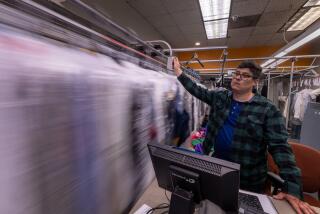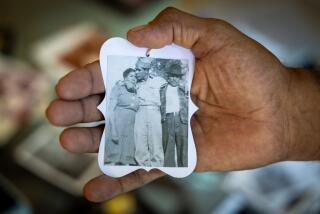Hellman buildings were inspired by national spirit
Brinks must be stuffing its armored delivery trucks with Goldman Sachs’ annual bonuses. The company’s compensation and benefit pool for 2009 is expected to top $20 billion, an average of more than $600,000 for each of the 31,700 company employees whose jobs were saved a year ago by a taxpayer bailout. Among the questions raised by this bonanza: What will bankers do with the money?
How to Spend It magazine, published by London’s Financial Times, recommends traveling across India by private jet, powder skiing in wintry Japan and collecting priceless art. Donations to boutique charities are OK, but investing billions to benefit the public now in need is not on the list of 2010 spending tips.
Private gain and community good were not always mutually exclusive.
Here in L.A. a century ago, two pioneer bankers increased their wealth and built the city as it reached for national prominence.
In 1859, Isaias Hellman and his brother Herman immigrated to California from Bavaria. Profiting from gold-rush spoils, rising industrialism and laissez-faire economics, they shrewdly assembled the powerful Farmers & Merchants National Bank, with Isaias as president and Herman as vice president.
The prosperity of the Hellman bank, like other American businesses, came with a price. Private wealth grew in unregulated, polluted cities with open sewers and soot from coal-burning factories. Shoddy buildings and two-room flats were crowded along unpaved streets littered with garbage and animal carcasses. Streetcar accidents plagued daily commutes.
In grimy Chicago, a model of urban depravity, nation boosters opened an exposition in 1893 to promote American products and technology. More than 27 million men and women, the equivalent of nearly half of the U.S. population, toured display halls designed in a white, classical style that associated new America with the ancient democracies, Greece and Rome. This architectural Parnassus fired up citizens from Pennsylvania to California to improve their towns with buildings by architects recently trained in antiquity’s traditions. In Los Angeles, where social reform was taking root, the Hellmans embraced the national spirit when they razed their early homes.
As family biographer Frances Dinkelspiel recounts, the Hellmans saved money and raised their children modestly. Isaias and his wife, Esther, lived in an 1877 villa at Main and 4th streets. Herman and Ida Hellman lived nearby, at Spring and 4th streets. At first, the houses were quiet retreats outside the city center, but by 1900 downtown had caught up with the neighborhood.
In 1903, Herman committed to Southland growth and built a luxury office block on the site of his one-story cottage. He hired St. Louis architect Alfred Rosenheim, an MIT graduate, and ordered the best. Rosenheim came to Los Angeles and designed the Herman W. Hellman building using new steel construction, stained glass and marble.
At the time, the Hellman brothers were on bad terms, each blaming the other for an employee who embezzled $300,000. When construction costs tilted to a then-unimaginable $1 million, the conservative Isaias provoked Herman to quit the family bank. He left and became Isaias’ competitor as president of the Merchants National Bank. His development succeeded and with the buildings that followed made Spring Street the Wall Street of the West in the 1920s.
Isaias was not upstaged by Herman. Worried that the Farmers & Merchants branch at Main and Commercial streets was out of the way and that developers would push the city beyond downtown, the older brother sold his home on Main to the bank. Its location was prime, with busy hotels across the street and Henry Huntington’s Pacific Electric rail depot in the Italianate style rising two blocks south.
In 1905, a $500,000 Corinthian temple by L.A. architects Morgan, Walls & Morgan opened at Main and 4th, its stately exterior, marbled interior and three-story vault manifesting the strength of the Farmers & Merchants National Bank. The Isaias W. Hellman office building, also designed by the Morgan firm, was built along two sides of the bank.
The Hellman buildings were among the classical style museums, churches, city halls, hospitals, railroad terminals, apartments and post offices that went up across America after the Chicago fair. Main Street USA, dignified with pediment fronts, granite columns and bronze door entrances, began to rival the avenues of sophisticated Rome, Paris, London and Berlin.
Today, the Hellman offices and bank still stand, reconfigured for a 21st century downtown. What does not survive are Hellman-era civic ideals that rallied two bankers to invest their fortunes in their adopted city. Think what 31,700 bankers could do today.
Watters’ column, which recounts Southern California social history through homes and gardens that have been demolished or altered beyond recognition, runs monthly. Past columns: latimes.com/lostla. Comments: [email protected].
More to Read
The biggest entertainment stories
Get our big stories about Hollywood, film, television, music, arts, culture and more right in your inbox as soon as they publish.
You may occasionally receive promotional content from the Los Angeles Times.










